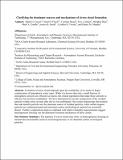| dc.contributor.author | Cziczo, Daniel James | |
| dc.contributor.author | Froyd, Karl D. | |
| dc.contributor.author | Hoose, Corinna | |
| dc.contributor.author | Jensen, Eric J. | |
| dc.contributor.author | Diao, Minghui | |
| dc.contributor.author | Zondlo, Mark A. | |
| dc.contributor.author | Smith, Jessica B. | |
| dc.contributor.author | Twohy, Cynthia H. | |
| dc.contributor.author | Murphy, Daniel M. | |
| dc.date.accessioned | 2014-06-09T21:05:17Z | |
| dc.date.available | 2014-06-09T21:05:17Z | |
| dc.date.issued | 2013-05 | |
| dc.identifier.issn | 0036-8075 | |
| dc.identifier.issn | 1095-9203 | |
| dc.identifier.uri | http://hdl.handle.net/1721.1/87714 | |
| dc.description.abstract | Formation of cirrus clouds depends on the availability of ice nuclei to begin condensation of atmospheric water vapor. Although it is known that only a small fraction of atmospheric aerosols are efficient ice nuclei, the critical ingredients that make those aerosols so effective have not been established. We have determined in situ the composition of the residual particles within cirrus crystals after the ice was sublimated. Our results demonstrate that mineral dust and metallic particles are the dominant source of residual particles, whereas sulfate and organic particles are underrepresented, and elemental carbon and biological materials are essentially absent. Further, composition analysis combined with relative humidity measurements suggests that heterogeneous freezing was the dominant formation mechanism of these clouds. | en_US |
| dc.description.sponsorship | National Science Foundation (U.S.) (NSF AGS-0840732) | en_US |
| dc.description.sponsorship | National Science Foundation (U.S.) (NSF grant AGS-1036275) | en_US |
| dc.description.sponsorship | United States. National Aeronautics and Space Administration (NASA Earth and Space Science Graduate Fellowship) | en_US |
| dc.description.sponsorship | United States. National Aeronautics and Space Administration (NASA Radiation Sciences Program award number NNX07AL11G) | en_US |
| dc.description.sponsorship | United States. National Aeronautics and Space Administration (NASA Radiation Sciences Program award number NNX08AH57G) | en_US |
| dc.description.sponsorship | United States. National Aeronautics and Space Administration (NASA Earth Science Division Atmospheric Composition program award number NNH11AQ58UI) | en_US |
| dc.language.iso | en_US | |
| dc.publisher | American Association for the Advancement of Science (AAAS) | en_US |
| dc.relation.isversionof | http://dx.doi.org/10.1126/science.1234145 | en_US |
| dc.rights | Creative Commons Attribution-Noncommercial-Share Alike | en_US |
| dc.rights.uri | http://creativecommons.org/licenses/by-nc-sa/4.0/ | en_US |
| dc.source | Prof. Cziczo via Chris Sherratt | en_US |
| dc.title | Clarifying the Dominant Sources and Mechanisms of Cirrus Cloud Formation | en_US |
| dc.type | Article | en_US |
| dc.identifier.citation | Cziczo, D. J., K. D. Froyd, C. Hoose, E. J. Jensen, M. Diao, M. A. Zondlo, J. B. Smith, C. H. Twohy, and D. M. Murphy. “Clarifying the Dominant Sources and Mechanisms of Cirrus Cloud Formation.” Science 340, no. 6138 (June 14, 2013): 1320–1324. | en_US |
| dc.contributor.department | Massachusetts Institute of Technology. Department of Earth, Atmospheric, and Planetary Sciences | en_US |
| dc.contributor.approver | Cziczo, Daniel James | en_US |
| dc.contributor.mitauthor | Cziczo, Daniel James | en_US |
| dc.relation.journal | Science | en_US |
| dc.eprint.version | Author's final manuscript | en_US |
| dc.type.uri | http://purl.org/eprint/type/JournalArticle | en_US |
| eprint.status | http://purl.org/eprint/status/PeerReviewed | en_US |
| dspace.orderedauthors | Cziczo, D. J.; Froyd, K. D.; Hoose, C.; Jensen, E. J.; Diao, M.; Zondlo, M. A.; Smith, J. B.; Twohy, C. H.; Murphy, D. M. | en_US |
| dc.identifier.orcid | https://orcid.org/0000-0003-1851-8740 | |
| mit.license | OPEN_ACCESS_POLICY | en_US |
| mit.metadata.status | Complete | |
